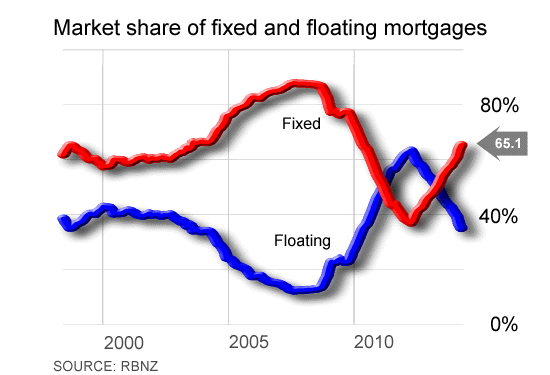
The rate of growth in household credit is continuing to slow - something that will please the Reserve Bank, which was concerned last year about a spurt in borrowing.
Introduction of high loan to value lending limits was one step the central bank took to cool lending activity.
Latest sector credit figures from the RBNZ show that in April total household claims (mortgages plus consumer borrowing) rose by a seasonally-adjusted 0.3%, which is down from the 0.4 in each of the previous three months and is in fact the slowest rate of growth since September 2012. In May 2013 the rate of growth was 0.6%.

Total household claims rose to $205.577 billion, from $204.924 billion in March, with the annual rate of growth slowing to 5.4% from 5.6% as of March.
In terms of just mortgage borrowing alone, the total rose to $191.248 billion from $190.6 billion, with the annual rate of growth likewise slowing to 5.4% from 5.6%.
Within the mortgage market the move to fix interest rates has continued at pace (as per accompanying chart).
The amount of money still on floating rates has in April declined to a little under 34.9% from around 36.5% just a month earlier.
As of April last year the proportion of mortgage borrowing money on floating rates was actually over 50%, but as people realised that interest rates would likely go up, so they started to fix. And with the RBNZ having hiked rates twice since March the move from floating to fixed has gathered even greater impetus.
One-to-two year fixed rates are currently attracting the most attention, with the amount on these having surged by another $2 billion in just the past month and the grand total on one-to-two year rates now standing at $37.611 billion. Two-to-three year rates are also popular with the total on these rates climbing to $16.804 billion from $35.604 billion in March.
The total on floating rates dropped by over $2.5 billion, while the amount fixed for less than a year dropped by nearly half a billion dollars.
Back on the sector credit figures, the total for consumer borrowing fell to $14.328 billion from $14.381 billion, resulting in a drop in the annual percentage growth figure to 4.6% from a revised 5.4% the previous month.
In other sectors, the total amount borrowed by the agricultural sector dropped slightly to $51.851 billion from $51.887 billion, with the rate of annual increase steady at 2.3%.
Business borrowing increased to $79.582 billion from $79.053 billion, but the annual rate of growth declined to 2.6% from 3.3%.
1 Comments
David in a debt based money supply you can't slow the growth of credit, it has to grow or the system collapses. So a reduction in credit won't please the reserve bank at all, what they want is an increase in credit, which actually needs to be exponential, but a reduction in prices to maintain stability ie: an increase in volume with only modest price increases.

We welcome your comments below. If you are not already registered, please register to comment.
Remember we welcome robust, respectful and insightful debate. We don't welcome abusive or defamatory comments and will de-register those repeatedly making such comments. Our current comment policy is here.